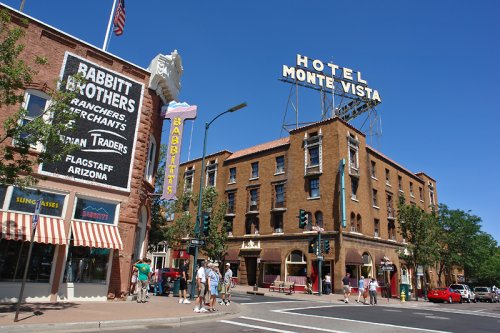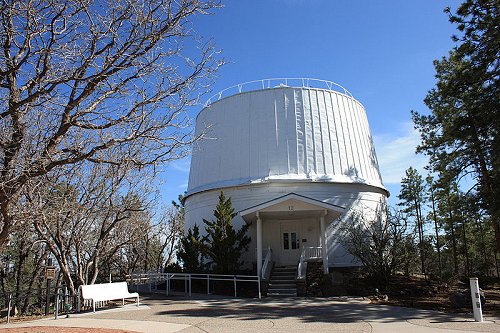 Flagstaff, Arizona
Flagstaff, ArizonaSource: https://commons.wikimedia.org/wiki/File:Flagstaff_downtown_SFmtn.jpg
Author: Derek.cashman

Flagstaff is a city and county seat of Coconino County, on the northern part of Arizona. The city covers 63.6 sq mi (164.8 sq km) and has a population of 60,000. The surrounding metropolitan statistical area has a total population of around 130,000.
Flagstaff was named established on the centennial of the United States on 4 July, 1876. The area was first surveyed by Lieutenant Edward Fitzgerald Beale in 1855. Lieutenant Beale had his men cut a flagpole of Ponderosa Pine to fly the flag of the United States, and hence the site became known as Flagstaff.
 Downtown Flagstaff
Downtown FlagstaffSource: https://commons.wikimedia.org/wiki/File:Flagstaff_AZ_-_downtown_hotel.jpg
Author: SearchNet Media

Flagstaff is the site of the Lowell Observatory. The site was chosen by astronomer Percival Lowell in 1894, who found it ideal for putting up a telescope. Two years later, the Clark telescope was installed. It was here in 1930 that the planet Pluto was discovered. The Clark Telescope was also used to map the moon for the lunar expeditions of the Apollo program in the 1960's. In recognition of the role Flagstaff played in astronomy, the asteroid 2118 was named after the city.
 Lowell Observatory, Flagstaff
Lowell Observatory, FlagstaffSource: https://commons.wikimedia.org/wiki/File:Lowell_Observatory_2009.jpg
Author: Kaldari

Visiting Flagstaff, Arizona
By PlaneThe Flagstaff Pulliam Airport (FLG) receives regular flights by Horizon Air from Los Angeles and US Airways from Phoenix.
By Road
Interstate I-40 passes through Flagstaff from east to west while I-17 links it to Phoenix in the south.
Places of Interest in Flagstaff, Arizona
- Arizona Historical Society-Pioneer Museum
- Lowell Observatory
- Museum of Northern Arizona
- Riordan Mansion State Historic Park
- The Aboretum at Flagstaff
 Latest updates on Penang Travel Tips
Latest updates on Penang Travel Tips

Copyright © 2003-2025 Timothy Tye. All Rights Reserved.

 Go Back
Go Back